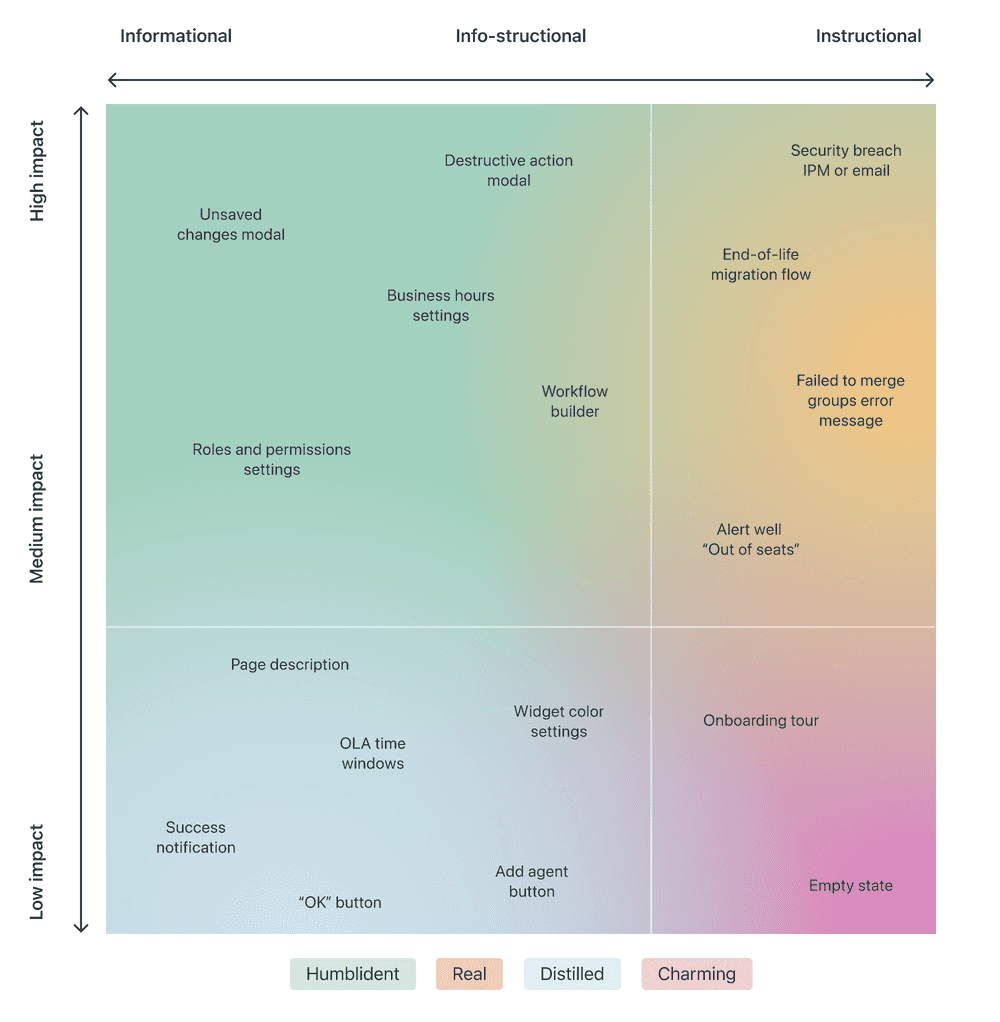Voice and tone
Our product is an extension of our brand. We use visual design to shape what Zendesk looks like, and voice and tone to shape what Zendesk sounds like.
How to sound like Zendesk
Our product is an extension of our brand and we want it to feel like Zendesk. We use visual design to shape what Zendesk looks like, and voice and tone to shape what Zendesk sounds like.
| Voice | Tone |
|---|---|
| About us | About them |
| Consistent | Variable |
While brand voice is typically unchanging, a brand’s tone varies across each user experience. A system failure isn’t the right time to be charming. And using a distilled tone could make an onboarding experience feel cold and unwelcoming.
Tone Framework
The Zendesk tone framework can help determine which brand tone to use and when. To create this framework we plotted dozens of user interactions across two dimensions.
- Informational vs instructional
- Low impact vs high impact
Informational
Information for the user to know. They don’t have to act on this content, but it is useful for their workflow.
Instructional
Instructions for a user to learn or act on. This content generally requires more attention to understand.
Low impact
Useful but not indispensable. Even if a user skimmed this content, they could safely navigate the product.
High impact
Stuff that really matters. Whether good news or bad, this content has a direct impact on a user’s success in the product.
Mapping tone
After plotting these user interactions, we outlined four quadrants that were a natural fit for our brand tones.

Low impact and informational
Tone to use: Distilled
Character: An efficient surgeon
| What users expect | How to sound Distilled |
|---|---|
| Contextual useful feedback. This content appears right when the user needs it: in labels, tooltips, and auto-dismissing alerts. It’s good to know, but not to remember. | Distilled means spare, precise, and focused. What surgeons know: precise action takes precise communication. Use the Distilled tone to say it quickly and clearly. Nuance and charm can get in the way of transactional experiences or basic user feedback. |
High impact and informational
Tone to use: Humblident
Character: A resolute sherpa
| What users expect | How to sound Humblident |
|---|---|
| Mindful memos to our user, not directives. Warnings and unsaved changes modals tell our users something is up, but leave it up to them to decide their best course of action. | Humblident means even, calm, and knowledgeable. The sherpa knows the way up the mountain, but you’re the one who climbs it. Zendesk’s Humblident tone (a proprietary mix of ‘humble’ and ‘confident’) is how we empower users to make choices. We don’t ask “Are you sure?” because informed users know what’s right for them. |
High impact and instructional
Tone to use: Real
Character: Your no-B.S. best friend
| What users expect | How to sound Real |
|---|---|
| Concepts to learn and act upon. A failure or security breach email, for example. The content goes beyond information; it must assure and guide the user to the best course of action for them. | Real means direct, candid, and respectful. We love our no B.S. besties because they say what needs to be said—even the hard stuff—from a place of empathy. Use the Real tone whenever there’s potential for disappointment. Deprecated feature? Hacked account? Skip the sugar-coated corp-speak and never make jokes. Real is the sweet spot between Charming and Distilled: tell it like it is. |
Low impact and instructional
Tone to use: Charming
Character: A fastidious host
| What users expect | How to sound Charming |
|---|---|
| Actionable but not imperative content. Onboarding and empty states are cool, but not mandatory to get work done. Content’s job is to make these experiences worthwhile and delightful for the user. | Charming means refreshing, warm, and well-timed. A great host knows the right thing to say and how to say it. A sprinkle of Charming tone adds warmth (and umami) to the product. It’s perfect for low-stakes interactions where the user has more time to read and less to do. But don’t overdo it. The goal is a smile, not a LMFAO. We’re here to serve, not entertain. |